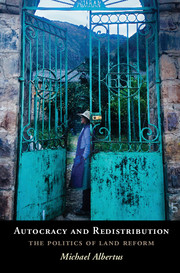Book contents
- Frontmatter
- Contents
- List of Tables
- List of Figures
- Acknowledgments
- 1 Introduction
- 2 Actors, Interests, and the Origins of Elite Splits
- 3 A Theory of Land Reform
- 4 Measuring Land Reform
- 5 A Cross-National Analysis of Land Reform in Latin America
- 6 Elite Splits and Redistribution under Autocracy: Peru's “Revolution from Above”
- 7 Land Reform Transformed to Redistribution: Venezuela's Punto Fijo Democracy and Chávez's Bolivarian Revolution
- 8 Latin America in Comparative Perspective
- 9 Conclusion
- References
- Index
- Other Books in the Series
4 - Measuring Land Reform
Published online by Cambridge University Press: 05 October 2015
- Frontmatter
- Contents
- List of Tables
- List of Figures
- Acknowledgments
- 1 Introduction
- 2 Actors, Interests, and the Origins of Elite Splits
- 3 A Theory of Land Reform
- 4 Measuring Land Reform
- 5 A Cross-National Analysis of Land Reform in Latin America
- 6 Elite Splits and Redistribution under Autocracy: Peru's “Revolution from Above”
- 7 Land Reform Transformed to Redistribution: Venezuela's Punto Fijo Democracy and Chávez's Bolivarian Revolution
- 8 Latin America in Comparative Perspective
- 9 Conclusion
- References
- Index
- Other Books in the Series
Summary
One of the main practical challenges to understanding the politics of land reform is to gain an understanding of broad patterns of land reform over time. What precisely constitutes land reform? Have land reform policies changed over time and, if so, how? Where and when has land reform been implemented most intensely, and what consequences has it had?
There is a large body of literature on land reform that provides useful guidance regarding these questions. In addition to a host of case studies of land reform, there are a number of insightful compilations of reform analyses (e.g., Barraclough 1973; Binswanger-Mkhize, Bourguignon, and van den Brink 2009; Dorner 1992; Rosset, Patel, and Courville 2006; Thiesenhusen 1989). There is also a vein of research that attempts to make sense of the broad patterns of land reform as well as its efficacy in addressing a range of social issues such as poverty, inequality, and social inclusion (e.g., El-Ghonemy 2002; Herring 1983; Huntington 1968; Lapp 2004; Lipton 2009; Tai 1974; Thiesenhusen 1995; Tuma 1965).
The conclusions drawn from these studies are nearly as varied and numerous as the studies themselves. Some find that land reform has a largely successful record (Lipton 2009), whereas others lament its failures (Thiesenhusen 1995). Those that seek to explain the incidence and timing of reform conclude that land reform is most likely to occur under democracy as a consequence of political competition over rural votes (Lapp 2004), when single or hegemonic party structures dominate politics (Huntington 1968), or when “non-competitive” political systems with centralized power can overrun the resistance of landed interests (Tai 1974).
The widely varying findings on land reform in existing research are largely the result of differences in research design, data, and spatial and temporal scope. Many compilations of land reform select their cases based on the dependent variable, focusing on cases of significant reform at the expense of understanding why reforms took place in that set of cases in the first place. And although many of the case studies and works with broader scope provide key insights into land policies in selected states, it is hard to draw broader conclusions from them.
- Type
- Chapter
- Information
- Autocracy and RedistributionThe Politics of Land Reform, pp. 112 - 141Publisher: Cambridge University PressPrint publication year: 2015

